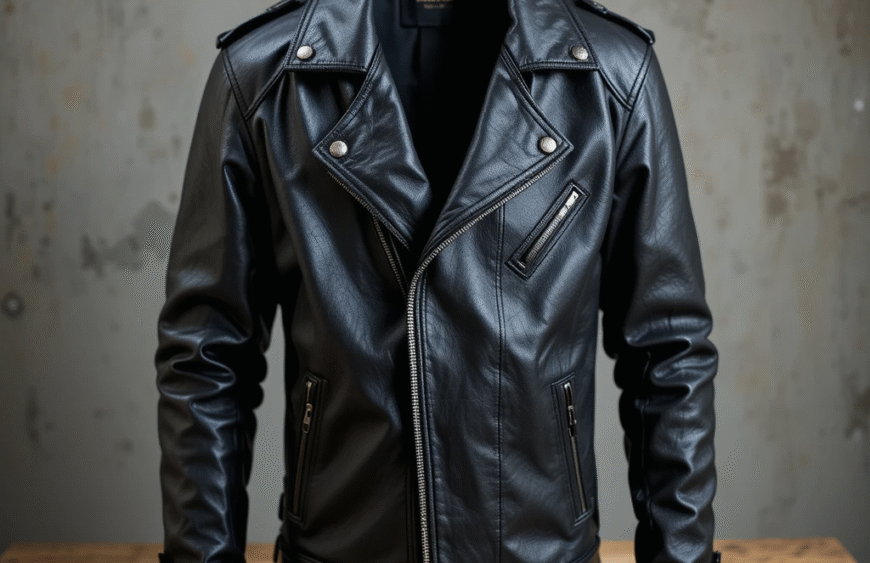How to Remove Mould from Leather Jacket
Introduction
Have you ever pulled your leather jacket out of storage, only to find it covered in fuzzy, smelly mould? Ugh, that sight can be a total heartbreak—especially if it’s your favorite piece. Mould on leather doesn’t just look bad—it can ruin the material if not treated properly. But don’t worry, because getting rid of mould from a leather jacket is totally doable at home with the right approach.
Think of mould like an uninvited guest at a party—one that makes itself too comfortable and leaves a mess behind. This guide will walk you through every step to kick it out for good. From simple household ingredients to long-term prevention tips, we’ve got everything covered.

1. What Causes Mould on Leather?
Mould forms when moisture and warmth meet organic material—in this case, leather. Leather is porous and breathable, which makes it prone to soaking up moisture from the air. Combine that with poor ventilation and darkness, and you’ve created a perfect environment for mould to grow.
So if you left your jacket in a damp closet, a garage, or any humid place for too long—voilà, mould city.
2. How to Identify Mould on Leather
Not sure if it’s mould or just dirt? Here’s how to tell:
- Look: Mould often appears as white, green, or gray spots. It may be fuzzy or powdery.
- Smell: That musty, earthy smell? That’s a dead giveaway.
- Feel: Mould can leave the surface feeling sticky or slimy.
If your jacket checks these boxes, it’s time to clean it up.
3. Is Mould Dangerous to Your Health?
Short answer—yes. Mould spores can trigger allergic reactions, skin irritation, and even respiratory issues if you inhale them regularly.
That’s why it’s important to clean your leather jacket in a well-ventilated area, wear gloves, and maybe even a mask. Protect yourself while you protect your clothes.
4. Supplies You’ll Need
Before diving into the cleaning process, gather the following items:
- Soft brush or dry cloth
- White vinegar or rubbing alcohol
- Water
- Mild soap or leather cleaner
- Spray bottle
- Microfiber cloths
- Leather conditioner
- Gloves and a face mask
You probably already have most of these around the house.
5. Step-by-Step Guide to Remove Mould
Ready to get that jacket looking fresh again? Here’s how:
Step 1: Take it Outside
Always clean mould outdoors if you can. This prevents spores from spreading indoors.
Step 2: Dry Brush the Jacket
Use a soft brush or dry cloth to gently remove loose mould. Do not rub hard—you don’t want to grind spores deeper into the leather.
Step 3: Mix Your Cleaner
In a spray bottle, mix 1 part white vinegar (or rubbing alcohol) with 1 part water.
Step 4: Apply the Solution
Lightly spray the mixture onto a clean cloth, not directly on the jacket. Gently wipe the affected areas.
Step 5: Wipe with Clean Water
Dampen another cloth with plain water and wipe off the cleaning solution.
Step 6: Dry Properly
Let the jacket dry completely in a shaded, well-ventilated area. Avoid direct sunlight—it can dry out and crack the leather.
6. Natural Remedies for Mould Removal
If you prefer a natural route, you’re in luck. White vinegar is not just for salads—it kills about 80% of mould species.
Alternatively, tea tree oil (diluted with water) is a powerful antifungal. A few drops in a spray bottle with water can be used just like the vinegar solution.
7. Cleaning Mould from the Jacket Lining
Sometimes the mould hides inside. Flip your jacket inside-out and inspect the lining.
- Use the same vinegar-water solution
- Test a small patch first
- Gently scrub and dry thoroughly
Be sure the inside is completely dry before storing it again.
8. Drying and Conditioning the Leather
After cleaning, your leather might feel a little stiff. That’s normal.
Why Conditioning is Important:
Leather, like skin, loses its natural oils over time. Use a quality leather conditioner to restore softness and flexibility.
Apply a small amount using a microfiber cloth, rub it in gently, and let it soak for a few hours.
9. When to Seek Professional Help
If:
- The mould covers more than 50% of the jacket
- There’s a strong odor that won’t go away
- The leather feels slimy or discolored even after cleaning
How to Remove Mould from Leather Jacket it’s time to call in the pros. A leather specialist can clean deeply without damaging your jacket.
10. How to Prevent Mould in the Future
Prevention is always better than cure. Here’s how to stop mould before it starts:
- Store in a dry, cool place
- Use silica gel packs to absorb moisture
- Don’t cover leather in plastic—it traps humidity
- Clean regularly to remove oils and dirt that feed mould
Think of it like brushing your teeth—routine care prevents big problems.
11. Can You Wash Leather in a Washing Machine?
In one word: No.
Leather and washing machines are mortal enemies. Water can warp, shrink, and damage the material permanently.
Stick to gentle hand cleaning with the right tools.
12. How Storage Affects Mould Growth
Where and how you store your jacket matters a lot. Avoid:
- Damp basements
- Unventilated closets
- Plastic garment bags
Opt instead for breathable cotton covers in dry, airy spaces. A simple tweak in storage habits can keep mould away for good.
13. How Often Should You Clean Leather?
You don’t need to scrub it every week, but:
- Wipe down after every few wears
- Deep clean once or twice a year
- Condition every 6 months
This keeps the jacket not only mould-free but also looking sharp.
14. Common Mistakes to Avoid
How to Remove Mould from Leather Jacket: We all make mistakes, but these can ruin your jacket:
- Using bleach – It discolors and weakens leather
- Soaking the jacket – Water damage is real
- Skipping the drying step – Moisture invites more mould
- Forgetting to condition – Leads to cracks and stiffness
Treat leather like you would your skin—with care and patience.
15. Final Thoughts
How to Remove Mould from Leather Jacket: Mould on a leather jacket can be annoying, but it doesn’t mean the end of the road. With the right tools, some patience, and a little love, you can bring that jacket back to life. Think of it like a spa day for your leather—it deserves that kind of attention!
And remember, the key is not just cleaning—it’s preventing. Keep your jacket dry, clean, and properly stored, and it’ll stick around for many more seasons to come.
FAQs
1. Can vinegar damage leather jackets?
When diluted properly (1:1 with water), vinegar is safe and effective. Always test on a small spot first.
2. How long does it take to remove mould from leather?
About 30–60 minutes for light mould. Heavier growths may take more time and conditioning.
3. Will mould come back after cleaning?
It can, if moisture returns. That’s why proper drying and storage are essential.
4. Can I use baby wipes to clean mould from leather?
No, they may contain alcohol or oils that harm leather. Stick to proper leather-safe solutions.
5. What’s the best way to store leather jackets long-term?
Hang in a cool, dry place in a breathable garment bag. Add moisture absorbers for extra protection.
Read more: Leather Jacket The Ultimate Guide: Styles, Care, & Top Picks




